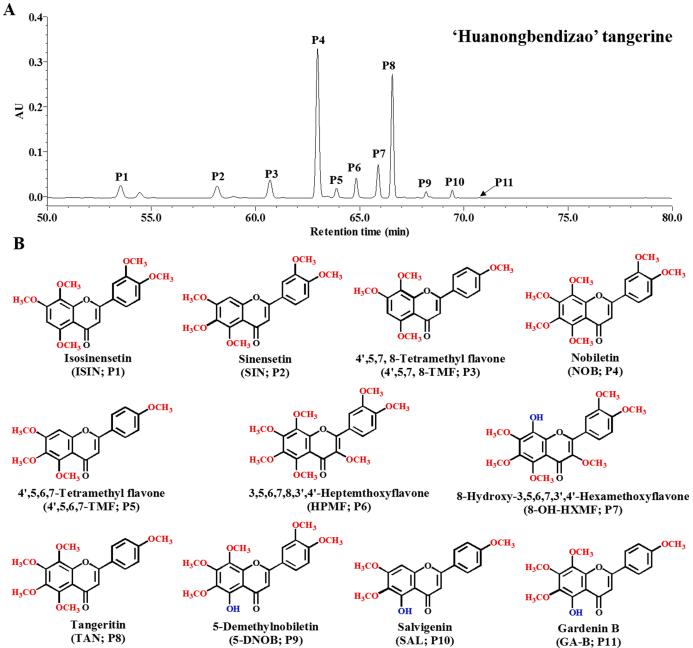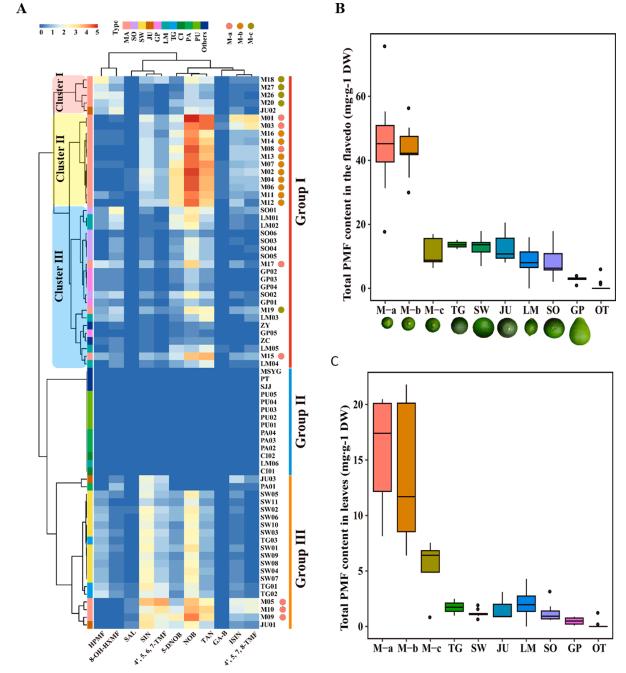What is Polymethoxylated Flavone?
Polymethoxylated flavones, commonly abbreviated as PMFs, form a specific subset of flavonoid compounds predominantly found in nature, with citrus fruits like oranges and lemons being notable sources. Their distinctive feature lies in the presence of multiple methoxy (-OCH3) groups within their molecular structure. These compounds have attracted substantial attention across the domains of biochemistry, nutrition, and healthcare, primarily owing to their promising health-related advantages.
Polymethoxylated flavones are renowned for their wide array of biological activities, encompassing antioxidant, anti-inflammatory, and anticancer properties. Researchers and industries alike exhibit keen interest in delving into the study and analysis of these compounds. This interest is driven by the desire to comprehend their prevalence in natural sources, assess their potential applications, and ensure the quality of products in various sectors, including dietary supplements, pharmaceuticals, and agriculture. The analysis of polymethoxylated flavones serves as a crucial step in unlocking their therapeutic potential while catering to the demands of both research and industry.
Polymethoxylated Flavone Analysis Services Offered by Creative Proteomics
Polymethoxylated Flavone Identification: We specialize in identifying and characterizing various polymethoxylated flavones, enabling you to precisely determine their presence in your samples.
Polymethoxylated Flavone Quantification: Our services extend to the quantitative analysis of polymethoxylated flavones, providing accurate measurements of these compounds in different sample types.
Purity Assessment: We assess the purity of polymethoxylated flavones, ensuring that the analyzed compounds meet the required quality standards.
Sample Preparation and Extraction: Our experts can assist in sample preparation and extraction procedures to ensure optimal results in polymethoxylated flavone analysis.
Customized Analytical Approaches: We offer tailored solutions to address your unique analytical requirements, adapting our methods to suit your specific projects.
Comparative Analysis: We can perform comparative analyses to assess variations in polymethoxylated flavone content across different samples or sources.
Stability and Shelf-Life Studies: Our services include evaluating the stability and shelf-life of polymethoxylated flavone-containing products to support product development and quality assurance.
Polymethoxylated Flavone Analytical Techniques
Polymethoxylated flavone analysis involves several analytical techniques, with a primary focus on mass spectrometry-based methods. Here are some commonly used techniques:
High-Performance Liquid Chromatography-Mass Spectrometry (HPLC-MS): HPLC coupled with mass spectrometry is a powerful tool for separating and identifying polymethoxylated flavones. Common instrument models include the Agilent 1290 Infinity II LC coupled with the Agilent 6550 iFunnel Q-TOF MS.
Gas Chromatography-Mass Spectrometry (GC-MS): GC-MS is employed for the analysis of volatile compounds, including certain polymethoxylated flavones. Common models include the Thermo Fisher Scientific Trace 1310 GC coupled with the Thermo Fisher Scientific TSQ 8000 MS.
Liquid Chromatography-Tandem Mass Spectrometry (LC-MS/MS): LC-MS/MS combines liquid chromatography with tandem mass spectrometry to enhance the sensitivity and specificity of polymethoxylated flavone analysis. Instrument models include the Waters Acquity UPLC coupled with the Waters Xevo TQ-XS MS.
Quadrupole Time-of-Flight Mass Spectrometry (Q-TOF MS): Q-TOF MS instruments are used for accurate mass determination and structural elucidation of polymethoxylated flavones. Common examples include the SCIEX TripleTOF 6600 and the Bruker maXis 4G.
Triple Quadrupole Mass Spectrometry (QQQ-MS): Triple quadrupole mass spectrometers are employed for targeted analysis and quantification of polymethoxylated flavones. Models include the AB Sciex 4000 QTRAP and Thermo Fisher Scientific TSQ Quantis.
List of Analyzed Polymethoxylated Flavone, including but not limited to
We can analyze a wide range of polymethoxylated flavones from various sources, ensuring that your specific requirements are met. Here is a partial list of compounds we can analyze:
| Type | Specific Substance |
|---|
| Citrus-Derived Polymethoxylated Flavones | Nobiletin, Tangeretin, Sinensetin, Hesperetin, Methoxyfisetin, 3',4',5,6,7-Pentamethoxyflavone |
| Herbal and Botanical Polymethoxylated Flavones | Oroxylin A, Chrysin, Baicalein, Wogonin, Hispidulin, Oroxin A |
| Other Polymethoxylated Flavones | Apigenin, Luteolin, Kaempferol, Quercetin, Isorhamnetin, 5,7-Dimethoxyflavone |
Sample Requirements for Polymethoxylated Flavone Assay
| Sample Requirement | Details |
|---|
| Sample Type | Plant extracts, dietary supplements, herbal extracts, etc. |
| Sample Quantity | 1-5 grams (plant extracts), 100-500 mg (dietary supplements) |
| Sample Form | Powder, liquid, or extract |
| Storage Conditions | Store at -20°C or below |
| Sample Preparation | For plant extracts: Homogenization in methanol. For dietary supplements: Dissolve in appropriate solvent. |
| Extraction Method | Solid-liquid extraction for plant extracts. Solvent extraction for dietary supplements. |
| Filtration | 0.22 μm syringe filter for plant extracts. Microfiltration may be needed for dietary supplements. |
| Analysis Turnaround Time | Typically 5-7 business days, with options for expedited service (additional charges may apply). |
| Reporting | Detailed report including compound identification, quantification, and purity assessment. |
If you would like to analyze other flavonoids or learn more, please contact us. We look forward to working with you.
Case: Comprehensive Analysis of Polymethoxyflavones (PMFs) in Citrus: Species-Specific Distribution, Tissue Accumulation, and Implications for Breeding
Background
The study focuses on Polymethoxyflavones (PMFs) in citrus, a group of compounds with potential health benefits. PMFs have been identified in various citrus species, but their distribution, accumulation, and the genetic factors behind their presence remain underexplored.
Samples
The study utilized 116 citrus accessions, including mandarins, sweet oranges, sour oranges, and other citrus types, to investigate the distribution of PMFs. These samples covered a range of citrus species and hybrids.
Technical Methods
- Identification of PMFs: Eleven main PMF compounds, including O-methylated and hydroxylated PMFs, were identified in various citrus tissues. High-Performance Liquid Chromatography with Diode Array Detector (HPLC-DAD) and Ultra-High-Performance Liquid Chromatography with Diode Array Detector and Electrospray Ionization Quadrupole Time-of-Flight Mass Spectrometry (UHPLC-DAD-ESI-QTOF-MS/MS) were used for compound identification.
- Spatiotemporal Distribution: The study examined the spatial distribution of PMFs in various citrus tissues, including fruit flavedo, leaves, stems, flowers, and more. It compared the accumulation of PMFs in different tissues across multiple citrus accessions. Principal Component Analysis (PCA) and Orthogonal Partial Least Squares-Discriminant Analysis (OPLS-DA) were used to analyze the data.
- Identification of Biomarkers: The study identified potential PMF biomarkers responsible for discriminating different citrus tissues based on Variable Importance in Projection (VIP) values.
- Temporal Accumulation Pattern: The temporal accumulation pattern of PMFs was explored throughout fruit development stages, focusing on the fruit flavedo. The study tracked how PMF levels changed from early fruit development to fruit maturation.
- Genetic Analysis: The researchers identified O-methyltransferase (OMT) genes related to PMF biosynthesis by analyzing the genomes of different citrus species. The number of OMTs in each species was assessed to identify potential OMT genes associated with PMF production.
Results
- PMFs were detectable only in mandarins and their hybrids, with specific PMFs being inherited from mandarin ancestors.
- PMFs were found to accumulate most in the early stages of fruit development and decreased during maturation.
- Specific citrus germplasms, including wild or early-cultivated mandarins, were identified as rich sources of PMFs, making them valuable for breeding programs aiming to increase PMF content.
- Genetic analysis revealed differences in the number of O-methyltransferase (OMT) genes among citrus species, with mandarins and sweet oranges having more OMTs, suggesting their potential role in PMF biosynthesis.
- Chemotaxonomic analysis based on PMF profiles allowed for reliable classification and phylogenetic insights into citrus species.
 Polymethoxylated flavones (PMFs) in the flavedo of 'Huanongbendizao' tangerine (C. reticulata)
Polymethoxylated flavones (PMFs) in the flavedo of 'Huanongbendizao' tangerine (C. reticulata)
 PMF content in natural citrus germplasms.
PMF content in natural citrus germplasms.
Reference
- Peng, Zhaoxin, et al. "Comparative profiling and natural variation of polymethoxylated flavones in various citrus germplasms." Food Chemistry 354 (2021): 129499.


 Polymethoxylated flavones (PMFs) in the flavedo of 'Huanongbendizao' tangerine (C. reticulata)
Polymethoxylated flavones (PMFs) in the flavedo of 'Huanongbendizao' tangerine (C. reticulata) PMF content in natural citrus germplasms.
PMF content in natural citrus germplasms.